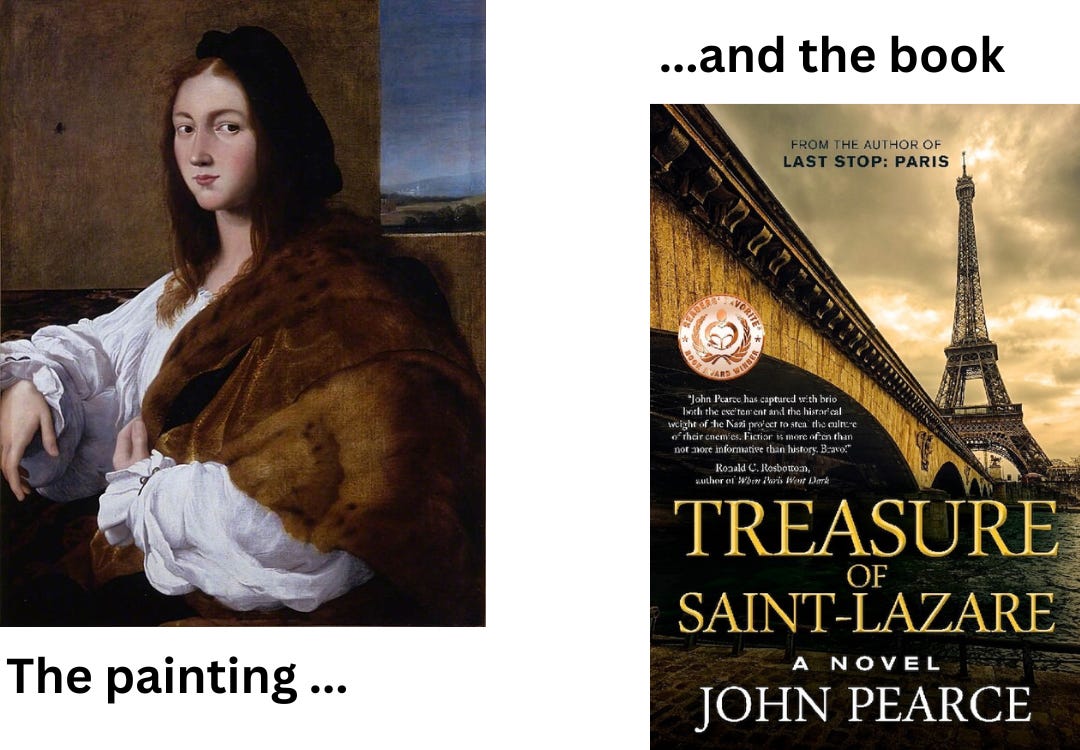The Vanished Masterpiece: Raphael’s Portrait of a Young Man
Occasionally I look back at the topic of my early novel Treasure of Saint-Lazare, which Readers' Favorite chose as the best historical mystery of its year.
Few paintings carry the weight of mystery and cultural loss quite like Raphael’s Portrait of a Young Man. Hailed as one of the finest examples of High Renaissance portraiture, it’s also among the world’s most famous missing artworks—a symbol of wartime plunder and the fragile fate of beauty in times of conflict.
A Masterpiece of the Renaissance
Painted around 1513–1514, Portrait of a Young Man reflects Raphael’s mastery at the height of his career. The subject, dressed in a flowing white chemise with a soft cap (which may be an illusion), gazes outward with an expression that is both reserved and quietly confident. One hand rests casually, holding a book or a glove, or possibly only the hem of his cloak. The other relaxes at the edge of a table.
The only known color reproductions of the painting are colorized, and their colors vary. The two reproduced on the painting's Wikipedia page are a good example.
Raphael’s subtle modeling of the face, the graceful lines, and the play of light and shadow make this portrait an intimate window into another era. It’s often compared to Leonardo da Vinci’s Mona Lisa for its psychological depth and elegance.
But who was this young man? That, too, remains a mystery. Some believe the painting may actually be a self-portrait of Raphael himself—one of the few that may have captured his likeness in such depth. Others suggest it could depict a member of the Florentine or Roman elite, perhaps one of his aristocratic patrons or intellectual companions.
Treasure of Saint-Lazare is available on Amazon in Kindle, paper, and audio editions, and is free in the Kindle Unlimited program.
From Treasure to Trophy
Before its disappearance, the painting belonged to the Czartoryski family of Poland, part of a collection that also housed Leonardo’s Lady with an Ermine. It was displayed in Kraków’s Czartoryski Museum, where it was admired as a national treasure.
Then came World War II.
When Nazi forces invaded Poland in 1939, they began looting the nation’s art with ruthless efficiency. Portrait of a Young Man was seized by Hans Frank, the Nazi governor of occupied Poland, who took it for the grand museum Hitler planned to build in Linz to rival the Louvre. It was last seen at his residence in Kraków and, according to contemporaneous documents, was shipped to his residence near Munich along with a king's ransom in gold bullion.
After 1945, it simply vanished.
Where Did It Go?
What happened to Portrait of a Young Man remains one of the great unsolved mysteries of the art world. Was it hidden in some secret vault, lost in the rubble of Germany’s collapse, or spirited away into the murky world of black-market art?
Numerous theories abound:
Some believe it lies in an unknown private collection, its true identity kept secret by collectors wary of legal repercussions.
Others fear it was destroyed in the war’s final battles.
Occasional rumors surface of sightings or sales, but none have been verified.
Frank's own son that his mother may have traded it to a farmer for butter.
More Than a Missing Painting
Beyond its artistic value, Raphael’s lost portrait has become a haunting symbol of the devastating cultural toll of war. It represents not just a missing masterpiece, but a missing piece of history—one that speaks to the lives, stories, and heritage violently disrupted by conflict.
It’s also a reminder that many other works of art stolen during World War II remain missing to this day, despite decades of recovery efforts.
The Search Continues
Poland has never stopped searching for Portrait of a Young Man. It remains listed on Interpol’s database of stolen cultural property, and art historians and detectives continue to follow leads.
For now, it survives only in photographs, copies, and the imaginations of those who dream that it might one day return to the light.
Would You Recognize It?
Take a moment to study its surviving image. Somewhere, perhaps in a hidden room or behind a false wall, Raphael’s Portrait of a Young Man may still wait to be found—its eyes watching, as it always has, in quiet confidence.
✒️ Have you ever followed the story of a lost artwork? Share your thoughts in the comments or email me.
John Pearce
Washington




Good idea to look back on and give excerpts of your earlier novels. I am trying to do same in my Substack. It gives our readers new opportunities and sometimes shows us that what we wrote at the time was "pas mal du tout" !